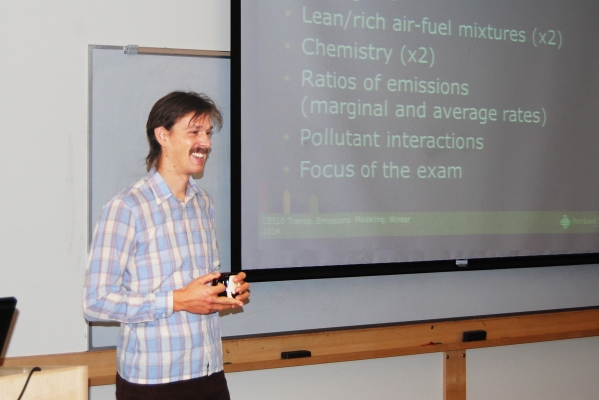Unique course puts emissions models in transportation engineers' hands

Portland State University engineering doctoral student Alex Bigazzi has developed a new course aimed at giving transportation engineers experience running emissions models. The course, Transportation Emissions Modeling, is offered through the Department of Civil and Environmental Engineering.
The practical nature of the course sets it apart from the few emissions courses offered at other universities, Bigazzi said. “Those tend to be on the policy side or the environmental side,” he said. “This is unique in trying to help engineers more than policymakers or future policymakers.”
The course fits with both Bigazzi’s own experience and Portland State’s faculty research strength in emissions and modeling. The university already offers an air quality course, but Bigazzi’s offering focuses narrowly on emissions from motor vehicles.
Students spent the first half of the inaugural course learning context for the models, including when they are used and what they can do. “There are federal requirements to do these models for all serious transportation projects,” Bigazzi said. “People need to understand what goes into them and how accurate they can be.”
Because emissions models aren’t as complex mathematically as other models, and because the Environmental Protection Agency’s MOVES model is freely accessible, students can spend more time learning exactly what the model can and can’t do.
“The important thing is understanding the inputs and outputs,” Bigazzi said, such as fuel types and formulations, engine types, the presence of exhaust controls, and inspection and maintenance programs. “It helps you to understand why these changes in the transportation system result in changes to emissions.”
Importantly, one thing the MOVES model can’t do is consider pollutants that aren’t regulated. For example, the tiny emissions particles called ultrafine particles, or UFPs, don’t show up in the model, despite the health implications of exposure.
That’s a personal concern for Bigazzi, who has looked at exposure to UFPs in his own research and in OTREC projects led by Miguel Figliozzi and Linda George. “Some of the emissions controls could actually increase UFP levels,” he said. His course, however, acknowledges those limitations while drawing a line at existing rules.
Bigazzi credits his involvement in the Transportation Research Board’s Transportation and Air Quality Committee with helping keep him up with those rules and giving him an idea of the changes in emissions law and modeling technology on the horizon.
“It’s a very rapidly changing field,” he said. “Three of the regulations we talked about (in class) today took effect in 2012 or 2014.”
In its first term, the Transportation Emissions Modeling course has enrolled seven undergraduate and three graduate students: two from engineering and one from planning. Others audit the course or stop by to observe.
Bigazzi said he could see demand for another course picking up where his leaves off, perhaps covering exposure to pollution and health effects. For now, he’s focused on finishing off his first course and guiding students through their final modeling projects.
“I appreciate the opportunity to do this,” he said. “It’s been a lot of fun so far, synthesizing a lot of information.”
Bigazzi presents his research on bicylists' uptake of traffic-related pollution at the Portland State Friday Transportation Seminar at noon, Friday, Feb. 28. Click here for details.
